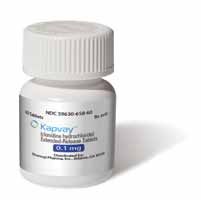Shionogi Pharma's Kapvay
The FDA approved Kapvay (clonidine hydrochloride extended -release) as a monotherapy and adjunctive therapy for the treatment of attention- deficit/hyperactivity disorder in children and adolescents aged 6 to 17 years.
The FDA approved Kapvay (clonidine hydrochloride extended-release) as a monotherapy and adjunctive therapy for the treatment of attention- deficit/hyperactivity disorder in children and adolescents aged 6 to 17 years.

On October 4, 2011, the FDA approved Kapvay (extended-release clonidine hydrochloride) from the Americanbased Shionogi Pharma, Inc as a monotherapy and adjunctive therapy for the treatment of attention-deficit/hyperactivity disorder (ADHD) in children and adolescents aged 6 to 17 years.1 Clonidine is traditionally used to treat high blood pressure or is paired with opiates for pain relief.
Pharmacology/ Pharmacokinetics
Although the mechanism of action of clonidine in ADHD remains unknown, Kapvay is a centrally acting alpha2-adrenergic receptor agonist and stimulates these receptors in the brain. Kapvay is not a central nervous system (CNS) stimulant.2
The pharmacokinetics of immediate and extended-release clonidine show dissimilar characteristics. Kapvay, as an extended-release formula, has a slower absorption rate and a more stable increase in plasma concentration than the immediate- release formulation. Food did not have an effect on the plasma concentrations, elimination half-life, and bioavailability of Kapvay.2
Clinical Trials
Two randomized, double-blind, placebocontrolled clinical trials were performed: 1 monotherapy (Study 1) and 1 adjunctive therapy (Study 2). Both trials were carried out for 8 weeks on children and adolescents aged 6 to 17 years. These subjects were diagnosed by the investigator with ADHD hyperactivity using the Diagnostic and Statistical Manual of Mental Disorders, Fourth Revision criteria and ADHD Rating Scale-IV (ADHD RS-IV): Parent Version.2
Study 1 included 236 patients and was a fixed-dose study in which participants were selected to receive either Kapvay 0.2 or 0.4 mg/day or placebo. In all cases, the dose started at 0.1 mg/day and increased 0.1 mg/week until the assigned dose was reached. ADHD symptoms were shown to decrease according to the ADHD RS-IV total score at both doses of Kapvay at the end of 5 weeks.2
Study 2 had 198 patients who were previously treated with either methylphenidate or amphetamine, both psychostimulants, for 4 weeks. Patients were selected to either receive Kapvay and the psychostimulant or continue the psychostimulant therapy alone. There was a greater improvement in ADHD RS-IV scores with the use of Kapvay and the psychostimulant than with psychostimulant therapy alone. These improvements were seen as early as 5 weeks.2
Precautions and Contraindications
Those who are sensitive to clonidine should not take Kapvay. Kapvay should be taken with the same precautions as any clonidine therapy.2
Kapvay may intensify the effects of CNS depressants. Tricyclic antidepressants may decrease clonidine’s hypotensive effect. Patients receiving other therapy known to affect atrioventricular (AV) nodal conduction or sinus node function should take Kapvay with caution, as there is a possibility for AV block and bradycardia additive effects.2
Decreases in blood pressure and heart rate are very often seen with clonidine therapy and both should be monitored closely when taking Kapvay. Although Kapvay has not been studied for use in adults, it is excreted in human milk; nursing women should exercise caution when taking Kapvay.2
Side Effects
The most common adverse events found in the 2 clinical studies include sleepiness, headache, and upper respiratory tract infections. There is also a small risk of side effects, including sore throat, ear pain, and nightmares.1
Dosage and Administration
Kapvay is available in doses of 0.1 to 0.4 mg/day. When initiating Kapvay treatment, it is recommended to increase the dose in increments of 0.1 mg until the desired dose is reached. Kapvay can be taken alone or as adjunct therapy to a psychostimulant. Doses greater than 0.1 mg/day should be divided into a morning and bedtime dose, taken either evenly or with the higher dose taken at bedtime.2 Kapvay treatment should be tapered down in dose increments of no more than 0.1 mg every 3 to 7 days when discontinuing therapy. Kapvay therapy longer than 5 weeks has not been studied. PT
Both Ms. Belisle and Dr. Patel are pharmacists at Brigham & Women’s Hospital, Boston, Massachusetts. Ms. Russo is a third-year pharmacy student at Northeastern University, Boston, Massachusetts.
References
1. Shionogi Inc. announces commercial availability of Kapvay (clonidine hydrochloride) extended-release tablets for the treatment of ADHD [press release]. Florham Park, NJ: Shionogi Inc.; January 10, 2011. www.prnewswire.com/news-releases/shionogi-inc-announces-commercial-availability-of-kapvay-clonidine-hydrochloride-extended-release-tablets-for-the-treatment-of-adhd-113195459.html. Accessed February 1, 2011.
2. Kapvay [product information]. Atlanta, GA: Shionogi Pharma, Inc; September 1, 2010.

